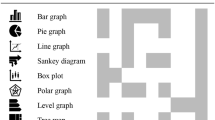Abstract
Aim, Scope and Background
The data-intensive nature of life cycle assessment (LCA), even for non-complex products, quickly leads to the utilization of various methods of representing the data in forms other than written characters. Up until now, traditional representations of life cycle inventory (LCI) data and environmental impact analysis (EIA) results have usually been based on 2D and 3D variants of simple tables, bar charts, pie charts and x/y graphs. However, these representation methods do not sufficiently address aspects such as representation of life cycle inventory information at a glance, filtering out data while summarizing the filtered data (so as to reduce the information load), and representation of data errors and uncertainty.
Main Features
This new information representation approach with its glyph-based visualization method addresses the specific problems outlined above, encountered when analyzing LCA and EIA related information. In particular, support for multi-dimensional information representation, reduction of information load, and explicit data feature propagation are provided on an interactive, computer-aided basis.
Results
Three-dimensional, interactive geometric objects, so called OM-glyphs, were used in the visualization method introduced, to represent LCA-related information in a multi-dimensional information space. This representation is defined by control parameters, which in turn represent spatial, geometric and retinal properties of glyphs and glyph formations. All relevant analysis scenarios allowed and valid can be visualized. These consist of combinations of items for the material and energy inventories, environmental items, life cycle phases and products, or their parts and components. Individual visualization scenarios, once computed and rendered on a computer screen, can then interactively be modified in terms of visual viewpoint, size, spatial location and detail of data represented, as needed. This helps to increase speed, efficiency and quality of the assessment performance, while at the same time considerably reducing mental load due to the more structured manner in which information is represented to the human expert.
Conclusions
The previous paper in this series discussed the motivation for a new approach to efficient information visualization in LCA and introduced the essential basic principles. This second paper offers more insight into and discussion on technical details and the framework developed. To provide a means for better understanding the visualization method presented, examples have been given. The main purpose of the examples, as already indicated, is to demonstrate and make transparent the mapping of LCA related data and their contexts to glyph parameters. Those glyph parameters, in turn, are used to generate a novel form of sophisticated information representation which is transparent, clear and compact, features which cannot be achieved with any traditional representation scheme.
Outlook
Final technical details of this approach and its framework will be presented and discussed in the next paper. Theoretical and practical issues related to the application of this visualization method to the computed life cycle inventory data of an actual industrial product will also be discussed in this next paper.
Similar content being viewed by others
References
Abello J, Korn J (2000): Visualizing massive multi-graphs. In: Proc. of the IEEE Symposium on Information Visualization‘00, October 9-13, Salt Lake City, Utah, USA, 39–47
Aho AV, Hopcroft JE, Ullman JD (1983): Data Structures and Algorithms. Addison-Wesley, Reading, Massachusetts, USA
Card SK, Mackinlay J, Shneiderman B (1999): Readings in Information Visualization: Using Vision to Think. Morgan Kaufmann, San Francisco, USA
Chang SK (1989): Principles of Pictorial Information Systems Design. Prentice-Hall, Englewood Cliffs, New Jersey, USA
Ebert DS, Rohrer RM, Shaw CD, Panda P, Kukla JM, Roberts DA (2000): Procedural shape generation for multi-dimensional data visualization. Computers and Graphics 24, 375–384
Feibleman JK (1969): An Introduction to the Philosophy of Charles S. Pierce. MIT Press, Cambridge, Massachusetts, USA
Golub GH, van Loan CF (1996): Matrix Computations. The Johns Hopkins University Press, Baltimore, USA
Gilbert JR, Moler C, Schreiber R (1992): Sparse matrices in MATLAB: Design and implementation. SIAM J Matrix Anal Appl 13 (1) 33–56
Im E-J (2000): Optimizing the performance of sparse matrix-vector multiplication, Ph.D. Dissertation, Department of Electrical Engineering and Computer Science, University of California, Berkeley, USA
ISO 14040 ff. DIN EN ISO 14040 ff: (1997) Umweltmanagement — ökobilanz. Beuth, Berlin, Germany
Otto HE, Mueller KG, Kimura F (2001): A Framework for Structured Data Retrieval in LCA using Feature Technology. In: Proc Eco-Design 2001: International Symposium on Environmentally Conscious Design and Inverse Manufacturing, December 11-15, Tokyo, Japan, 250–255
Otto HE, Mueller KG (2002): Structure and Evolution of Advanced OM-Glyphs. Research Note CR-KLO-03-02, Department of Precision Engineering, CAD/CAM Research, University of Tokyo
Otto HE, Mueller KG, Kimura F (2003): Efficient Information Visualization in LCA: Introduction and Overview. Int J LCA 8 (4) 183–189
Parker A, Cristou C, Cumming B, Johnson E, Hawken M, Zisserman A (1992): The analysis of 3D shape: Psychological principles and neural mechanisms. In: Humphreys G (ed), Understanding vision. Blackwell, Oxford, UK
Post FJ, van Walsum T, Post FH, Silver D (1995): Iconic techniques for feature visualization. In: Proc IEEE Symposium on Information Visualization‘ 95, October, 288–295
Ribarsky W, Ayers E, Eble J, Mukherja S (1994): Glyphmaker: Creating customized visualizations of complex data. IEEE Computer 27 (7) 57–64
Watkins DS (1991): Fundamentals of Matrix Computations. Wiley and Sons, New York, USA
Wirth N (1986): Algorithms + Data Structures = Programs. Prentice-Hall, Englewood Cliffs, New Jersey, USA
Author information
Authors and Affiliations
Corresponding author
Rights and permissions
About this article
Cite this article
Otto, H.E., Mueller, K.G. & Kimura, F. Efficient information visualization in LCA: approach and examples. Int J LCA 8, 259–265 (2003). https://doi.org/10.1007/BF02978917
Received:
Accepted:
Issue Date:
DOI: https://doi.org/10.1007/BF02978917




